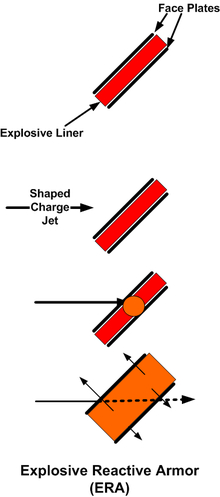In memory of our late CEO

OUT OF CHARACTER INFORMATION
- Intent: To create a new type of vehicle and ship armor.
- Image Source: Wikipedia.com
- Canon Link: N/A
- Permissions: My Subs ( Lucerne Labs, Directorate have explicit permission to use it as well)
- Primary Source: N/A
- Manufacturer: Guardian Authority Ltd.
- Affiliation: Guardian Authority Ltd., Lucerne Labs, Directorate
- Market Status: Closed-Market
- Model: N/A
- Modularity: 'No'
- Production: Limited
- Material: Durasteel(outer layer), Detonite(explosive layer), Quadranium(inner layer)
- Classification: Metal/Fuel
- Weight: Very Heavy
- Resistances:
- Energy: Extreme
- Kinetic: Very High
- Lightsabers: High
- Sonic: None
- EMP/ION: None
- Elemental: High
- Ablative in Nature
- Can be set to defensive strength by adding or decreasing Detonite
- HIT ME WITH YOUR BEST SHOT: The directed detonation (especially to projectiles) stops near all incoming shots in their tracks.
- FIRE AWAY: The second layer of Quadranium makes for an added surprise and layer of protection.
- WHOAH WHOAH! NO ONE SAID 3 TIMES!: Repeated shots in the same section will indeed break through the armor.
- HEAVY AS A HUTT'S TAIL: The armor's strength is its downfall as the weight limits the usage to larger vehicles and ships.
An element of explosive reactive armor is made out of a sheet or slab of high explosive sandwiched between two plates, typically metal, called the reactive or dynamic elements. On attack by a penetrating weapon, the explosive detonates, forcibly driving the metal plates apart to damage the penetrator. Against a shaped charge, the projected plates disrupt the metallic jet penetrator, effectively providing a greater path-length of material to be penetrated. Against a kinetic energy penetrator, the projected plates serve to deflect and break up the rod.
The disruption is attributed to two mechanisms. First, the moving plates change the effective velocity and angle of impact of the shaped charge jet, reducing the angle of incidence and increasing the effective jet velocity versus the plate element. Second, since the plates are angled compared to the usual impact direction of shaped charge warheads, as the plates move outwards the impact point on the plate moves over time, requiring the jet to cut through fresh plates of material. This second effect significantly increases the effective plate thickness during the impact.
To be effective against kinetic energy projectiles, ERA (Explosive Reactive Armour) must use much thicker and heavier plates and a correspondingly thicker explosive layer. Such "heavy ERA," can break apart a penetrating rod that is longer than the ERA is deep, again significantly reducing penetration capability.
An important aspect of ERA is the brisance or detonation speed of its explosive element. A more brisant explosive and greater plate velocity will result in more plate material being fed into the path of the oncoming jet, greatly increasing the plate's effective thickness. This effect is especially pronounced in the rear plate receding away from the jet, which triples in effective thickness with double the velocity.
ERA also counters explosively forged projectiles, as produced by a shaped charge. The counter-explosion must disrupt the incoming projectile so that its momentum is distributed in all directions rather than towards the target, greatly diminishing its effectiveness.
Last edited:







